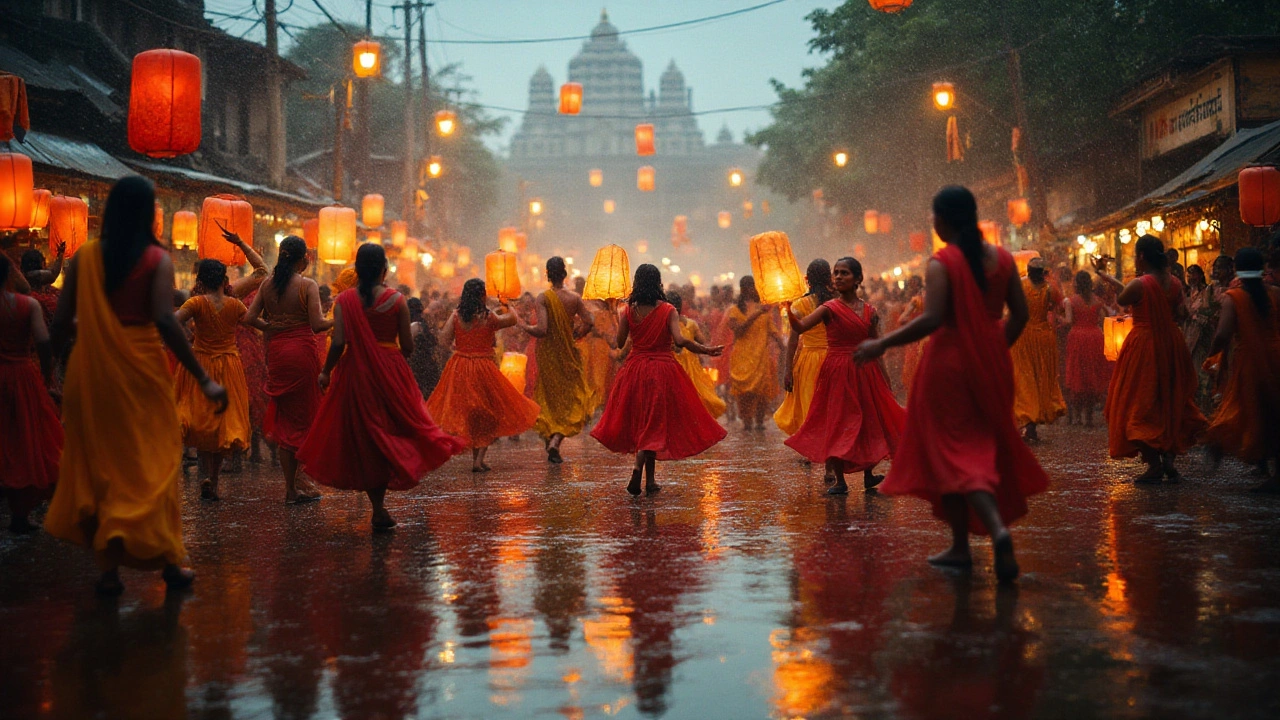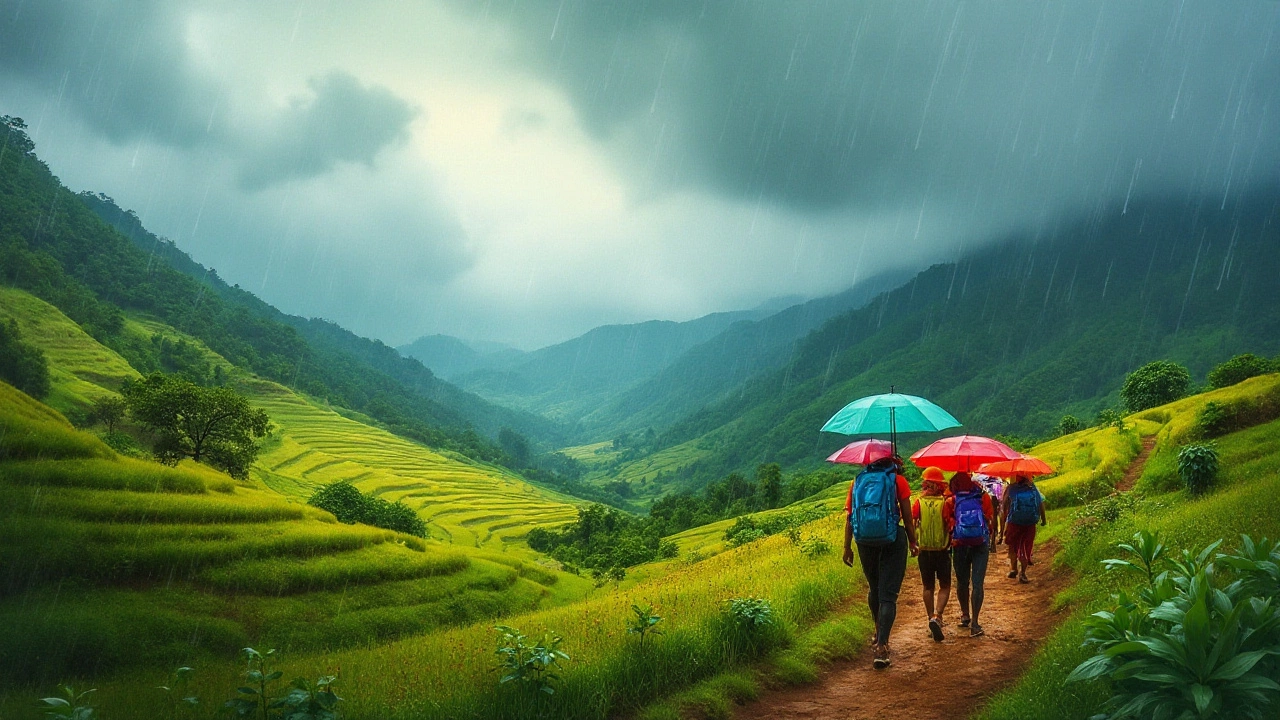South India, with its vibrant culture and rich landscapes, experiences a distinct rainy season that appeals to many travelers. The monsoon pours down from June to September, transforming the region into a lush tapestry of green hues. Understanding the timing and nature of this season is crucial for those planning their travel itinerary.
The monsoon's arrival is not just about rain; it is a time when the earth breathes anew, and life bursts forth in every corner. Travelers might find themselves captivated by the rain-swept terrains and the atmosphere of renewal and celebration across different communities. Whether you're wandering through Kerala's backwaters or exploring Tamil Nadu's temple towns, the rainy season brings a unique charm.
However, traveling during these months requires some preparation. Knowledge about local weather patterns, suitable gear, and safe transportation options are key to making the most out of a trip to South India during its monsoon phase. With the right mindset and resources, the rainy season offers an authentic glimpse into the rhythm of life in the south.
- When does the rainy season occur?
- Impact on travel and tourism
- Seasonal attractions
- Travel tips for monsoon season
When Does the Rainy Season Occur?
The rainy season in South India is as predictable as it is transformative. Unlike regions with erratic weather patterns, the monsoons arrive with a sense of punctuality, typically heralding their presence from June and often persisting until September. This annual occurrence is primarily driven by the southwest monsoon, which generously bathes the states of Kerala, Karnataka, Tamil Nadu, Telangana, and Andhra Pradesh. The onset is marked by a build-up of heavy moisture-laden clouds that often result in torrential rains, altering the landscape dramatically.
Historically, the rains brought by these monsoons have been vital not just for the agriculture-dependent economy but also for the cultural psyche of the region. Crops like rice, coconut, and our beloved spices flourish during this time. Each year, the anticipation of the monsoon is imbued with a mix of excitement and reverence. The earth seems to dance under the rhythmic drumming of rain, as rivers swell and waterfalls gush with renewed vigor.
The India Meteorological Department (IMD), the country's official weather forecasting agency, often declares the rain commencement dates. As noted in a report by the IMD, "South India receives approximately 75% of its annual rainfall during the monsoon months, emphasizing the season's crucial role in water replenishment."
While June marks the beginning across coastal Kerala, each state in South India boasts its unique climatic nuances. By July, rains are in full swing, painting the countryside in vibrant shades of green. Such widespread precipitation means that popular travel destinations are often cloaked in a beautiful veil of mist, adding to the area's mystique. However, it is crucial to note that these rains can lead to travel disruptions, so planning with flexibility in mind is advisable.
Travelers should be mindful that the unpredictability of weather during these months may lead to travel delays or cancellations, but the vibrant greenery and rejuvenated streams and rivers make the extra preparation worthwhile. With September's end, the monsoon slowly recedes, leaving behind a refreshed land, ready again to bask in the returning sunshine. The end of the monsoon signs off with a gentle drizzle, preparing the ground for the subsequent harvest and festive season ahead.
Impact on Travel and Tourism
The rainy season in South India significantly reshapes the landscape of travel and tourism. As the skies open up from June to September, the lush greenery that blankets the region attracts a unique segment of tourists seeking to experience the authentic monsoon charm. However, these months are both a boon and a challenge for the tourism industry. The refreshingly verdant landscapes become a playground for nature lovers and photography enthusiasts. The rhythmic patter of rain over tea estates in Munnar or the cascading waterfalls in Karnataka becomes a mesmerising sight. This natural spectacle, combined with lower tourist crowds, offers an intimate experience that is less possible during the bustling summer months.
Yet, there's a flip side to this monsoon magic. The rainfall, though enchanting, can sometimes disrupt travel plans with delayed or canceled flights, roadblocks, and heavy traffic. Coastal towns might experience flooding, and certain hilly terrains become risky with the threat of landslides. Tourist operators often have to adjust their itineraries to ensure safety, leading to impromptu changes that could affect the overall travel experience. Some outdoor activities may be limited in scope or accessibility due to safety concerns, which can mean missing out on certain attractions.
Economically, the monsoon season usually leads to a decline in international tourist arrivals. Statistics from the Ministry of Tourism often indicate a noticeable dip in the number of foreign visitors during these months compared to the dry season. However, savvy travelers frequently find this an opportune time to benefit from discounts and off-peak rates on accommodations and tour packages. The local businesses also adapt by offering monsoon-specific deals to entice travelers, allowing them to explore the beauty of South India without the premium costs associated with the high season.
"The monsoon is not merely rain; it is a festival of life that connects the land with the sky, a melodious dance that invites us to be a part of nature's grand performance," remarks a seasoned traveler on one of India's popular travel forums.
Despite the hurdles, the spirit of the monsoon is celebrated in many local festivals that occur during this period. These cultural events become an attraction in themselves, drawing visitors who are eager to witness the traditional dances, music, and rituals that are fervently celebrated amidst the rain. The snake boat races in Kerala and the vibrant festivities of Onam are iconic examples of how communities embrace and celebrate the monsoon.
Ultimately, while the rainy season presents its own set of obstacles, it also offers a distinct and memorable travel experience that many seasoned travelers cherish. By approaching the journey with flexibility, patience, and a readiness for unexpected adventures, tourists can find joy in the rejuvenating spirit of South India's monsoon.

Seasonal Attractions
When South India dons the veil of monsoon, its landscapes transform into an enchanting spectacle meant to be explored. The rainy season is not merely a period of showers but a catalyst that turns familiar sights into vibrant experiences. From the cascading waterfalls to the lush tea gardens, there is something magical about the way rain amplifies the beauty of the land. One of the most mesmerizing sights is the Athirapally Falls in Kerala, often referred to as the 'Niagara of India'. As you amble along its paths, the roar of the falls mingles with the melody of the rain, creating an auditory treat unlike any other.
Traveling during these months allows you to witness nature's pageantry up close. The Western Ghats, a UNESCO World Heritage site, become a lush paradise teeming with flora and fauna that thrive in the rain-soaked environment. For the eco-conscious traveler, this is the ideal time to explore the biodiversity of parks like the Periyar National Park. Here, amidst the gentle pitter-patter of rain, elephants and deer wander in their natural habitat, offering a glimpse into their world. Those who dare to traverse the verdant slopes of Munnar, known for its sprawling tea plantations, find themselves sipping world-class brews in the coziness of a mist-covered hill station.
Cultural festivities also beat a vibrant rhythm across South India during the monsoon. The state of Kerala celebrates the famous Onam festival in August or September, marking the harvest's bountiful arrival with floral decorations, traditional feasts, and boat races. Meanwhile, Tamil Nadu lights up with the vibrant celebrations of Aadi Perukku, a festival paying homage to the river goddess for a good monsoon. A visitor remarked,
"Experiencing South Indian festivals during the monsoon is like witnessing a burst of colors and rhythms that echo the heartbeat of the community."Indeed, these celebrations not only highlight the cultural richness of the region but also deeply connect travelers to the rhythm of the traditional monsoon lifestyle.
The unique travel opportunities extend beyond land to the serene backwaters of Kerala. As the rain gently kisses the surface of the water, houseboats glide smoothly, offering a tranquil escape and an intimate view of rural life. The monsoon paints a picturesque scene, with emerald paddy fields and groves of coconut trees standing vivid against the backdrop of gray clouds. For many, this is the ultimate romantic getaway, where time seems to slow and life adopts a more serene pace.
During this season, visiting South India's attractions becomes more than sightseeing; it transforms into an immersive journey into the very soul of the land. The monsoon immerses travelers in a tapestry woven from a myriad of sounds, sights, and stories waiting to be discovered. Whether it is the dramatic landscapes or cultural festivities, South India offers a genuinely unique experience for those adventuring through its rain-washed splendors.
Travel Tips for Monsoon Season
Embarking on a journey during the monsoon in South India can be thrilling, provided you are well-prepared. The rain-drenched landscapes and the smell of wet earth have a magical allure, yet, this season also demands a bit more thoughtfulness in planning. Packing the right essentials can turn a potentially cumbersome experience into an adventure of a lifetime. Start with waterproof clothing and a sturdy, adjustable umbrella; these are travel companions you don't want to leave behind. Lightweight, quick-dry fabrics are highly recommended to avoid the discomfort of heavy, soggy clothing. Additionally, shoes are a crucial consideration. Opt for waterproof footwear with a good grip to safely navigate the occasionally slick, rain-soaked steps and paths.
Keeping your belongings secure and dry is equally important as choosing the right clothing. Invest in waterproof bags or covers for your electronics and travel documents, which can be lifesavers when unexpected downpours hit. On a similar note, having a backup charger or a power bank is advisable as electricity can sometimes be unreliable during stormy weather. Even though it might seem like extra baggage, a small first-aid kit can prove invaluable if you find yourself far from medical facilities. Stock it with essentials, including antiseptics and waterproof bandages to ensure minor injuries don’t become major inconveniences.
The monsoon also affects transportation, making travel times less predictable. Leave room in your schedule for weather-related delays and always check the latest weather forecasts. Roads may become waterlogged, and certain remote routes might be temporarily inaccessible. It’s helpful to stay informed about local news, which often provides early warnings about severe conditions. At times, choosing a well-established mode of transportation, such as trains, can be more reliable and efficient than roads. Consider this while planning longer journeys across states or regions.
Staying Safe and Connected
Safety should always be a priority, especially when exploring rainy terrains and unfamiliar areas. During heavy rainfall, it is wise not to venture into low-lying areas prone to flooding or landslides. Know the location of your nearest safe haven, such as larger hotels or community centers, where you can find shelter quickly if needed. In addition, downloading relevant travel apps can be extremely helpful, offering instant access to weather updates, safe route suggestions, and emergency contact numbers. Always keep your phone charged, and when venturing out, let someone know your plan for the day.
For those looking for the best balance between weather and adventure, some activities and destinations thrive during the rainy season. Waterfalls are in their full glory, trekking routes offer a more challenging terrain, and certain festivals offer a cultural immersion that is simply unparalleled. However, the key to a successful monsoon expedition is flexibility and a positive attitude. Embrace sudden changes in plans with a sense of humor and a willingness to adapt, and you'll find the lush beauty of South India during monsoon to be an unforgettable experience.
